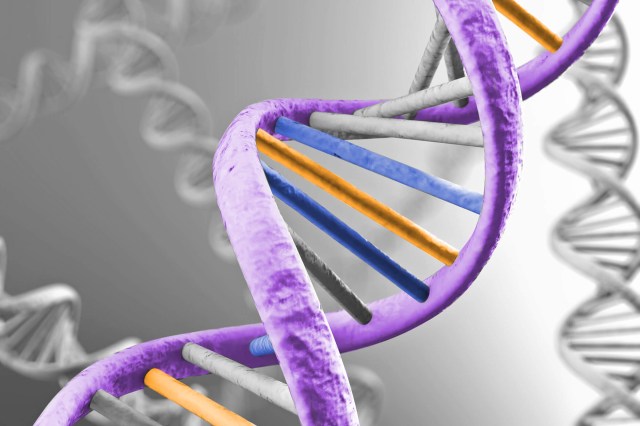
Human DNA Contains 3 Billion Base Pairs
Base pairs form the rung on the twisted DNA ladder, in which each “rung” is composed of nucleotides containing nitrogen bases adenine (A), thymine (T), guanine (G), and cytosine (C). Because adenine always pairs with thymine, and guanine to cytosine, DNA chains are often expressed as just a series of letters (e.g., “AGGTCCAATG” is an expression of 10 base pairs). Human DNA contains 3 billion of these base pairs stretched across 23 pairs of chromosomes, each with different instructions.
Of the total 46 chromosomes, we receive half from our mother and half from our father. The nucleus of every somatic cell (i.e., not sperm or eggs) in the human body contains these chromosomes, but certain cells only access the relevant chromosome for its particular function (eye color, for example, is restricted to a certain section of chromosome 15). DNA usually codes for a protein or group of proteins, which form cells that then become living tissue coalescing together into organs that, when put together, wind up as you.

Humans Share 98.8% of Their Genome With Chimpanzees
Sit a human next to another great ape, such as a chimpanzee or bonobo, and the differences are pretty stark — but our DNA suggests otherwise. The closest living genetic cousin to Homo sapiens, chimpanzees and bonobos each share about 98.8% of our DNA sequence. The similarity comes from the fact that humans shared a common ancestor with these primate species around 9.3 million to 6.5 million years ago, which is basically last week in the context of Earth history. But as humans, chimps, and bonobos evolved separately, the differences slowly grew, with each species adding its own divergent DNA. Although a 1.2% difference doesn’t seem like a lot, small changes in DNA can have major consequences. After all, with 3 billion base pairs, that means that there are still 35 million differences between humans and chimps. It’s also worth noting that even if we share genes with chimps, those genes can express differently, with some turned up high in humans, while the same gene can be a low hum in a chimp or bonobo. All of these differences combined is what separates humans from their primate cousins — and all other living things for that matter. In fact, humans share around 60% of their genes with bananas, and that’s something any self-respecting primate can get behind.

In the 19th Century, DNA Was Called “Nuclein”
Although our current understanding of DNA really started to take off with the description of the double helix structure in 1953, scientists had already known about the existence of DNA for nearly a century by that time. Swiss chemist Johann Friedrich Miescher discovered DNA in 1869, although to arrive at that discovery he had to undergo some less-than-savory science. At the time, Miescher was studying white blood cells, which fight infections and diseases. Although notoriously tricky to extract from a human’s lymph nodes, white blood cells could be found in abundance on used bandages. So Miescher traveled to local health clinics, took their used bandages, and wiped off the pus and grime. He then bathed the cells in warm alcohol to reduce the lipids and also used enzymes to eat through the proteins. What was left behind was some kind of gray matter that Miescher (successfully) identified as a previously unknown biological substance, which he called “nuclein.” In the early 1880s, German physician Albrecht Kossel discovered the substance’s acidic properties as well as the aforementioned nitrogen bases, and by the end of the decade, nuclein was renamed to the more accurate “nucleic acid.”
More Interesting Reads

The Discovery of DNA’s Double Helix Is Controversial
On May 6, 1952, British chemist Rosalind Franklin oversaw the taking of the first photograph depicting DNA’s double helix structure, at King’s College London. Technically her 51st X-ray diffraction pattern, the image became known as simply “Photo 51.” Yet the 1962 Nobel Prize for the discovery of the molecular structure of DNA only honored her colleague Maurice Wilkins, along with English physicist Francis Crick and American biologist James Watson. So what gives?
In 1953, Crick and Watson had written a paper revealing DNA’s twisting shape to the entire world, and only in the paper’s final paragraph mentioned that the discovery was “stimulated by a knowledge of the general nature of the unpublished experimental results and ideas” of two scientists at King’s College. In Watson’s own autobiography, he mentions that Franklin had no idea that her results had been shared with Crick and Watson via her colleague Wilkins, and when she published her own paper later, the reception wasn’t nearly as earth-shattering.
Recent studies have suggested that Franklin was a true collaborator with Watson and Crick, despite receiving much less credit than her male colleagues. Dying at age 37 in 1958 from ovarian cancer (likely due to her work with X-rays), Franklin was ineligible for the 1962 Nobel Prize. (By custom, the award was not handed out posthumously at the time, a rule that became codified in 1974.) Thankfully, history has slowly brought Franklin’s contributions to light and, in 2019, the European Space Agency even announced that their newest Mars rover would be officially renamed the “Rosalind Franklin” — a pretty stellar constellation prize.

All Humans Have Some Trace of Neanderthal DNA
DNA contains all the information that makes up all living things, but it also reveals interesting facts about our past. For one thing, all humans share 99.9% of the same genes, with the 0.1% caused by substitutions, deletions, and insertions in the genome (an important tool for understanding diseases). We also know, thanks to DNA, that humans are much less genetically diverse than other animal species. This means that all 8 billion humans today grew from a population of only 10,000 breeding pairs of Homo sapiens, and that our ancestors likely experienced genetic bottlenecks that caused serious population declines.
Amazingly, glimpses into our human lineage are also locked away in our DNA, because every human on the planet has some genetic material adopted from a completely different species of human — Neanderthals. Although Homo sapiens are the only human species on the planet today, the Earth has played host to upwards of 20 different human species throughout millions of years. For a time, Homo sapiens shared the planet with Neanderthals (Homo neanderthalensis) and even interbred with them. Remnants of those dalliances still live within our chromosomes, passed on from generation to generation. Although Europeans and Asians share the largest percentage of Neanderthal DNA (around 2%), Africans also share a small percentage (which wasn’t discovered until 2020).

Scientists Didn’t Finish Sequencing the Complete Human Genome Until 2022
In October 1990, the Human Genome Project formed to accomplish one goal: to sequence the entire human genome. Regarded as “one of the most ambitious and important scientific endeavors in human history,” the project essentially mapped a blueprint of human biology that greatly improved medicine and sequencing technology. It took 13 years to map the human genome (there are 3 billion base pairs after all), but the project finally declared success in 2003: ”We have before us the instruction set that carries each of us from the one-cell egg through adulthood to the grave,” said leading genome sequencer Robert Waterston at the time.
However, the announcement technically jumped the gun, because the Human Genome Project had only sequenced what was technologically possible, which came out to about 92% of the genome. The last 8% proved to be much trickier, because these regions contained highly repetitive DNA. Over the next two decades, advancements in DNA sequencing methods and computational tools allowed scientists to close the gap, and on April 1, 2022, the Telomere-to-Telomere consortium announced that all 3 billion base pairs had finally been sequenced.











